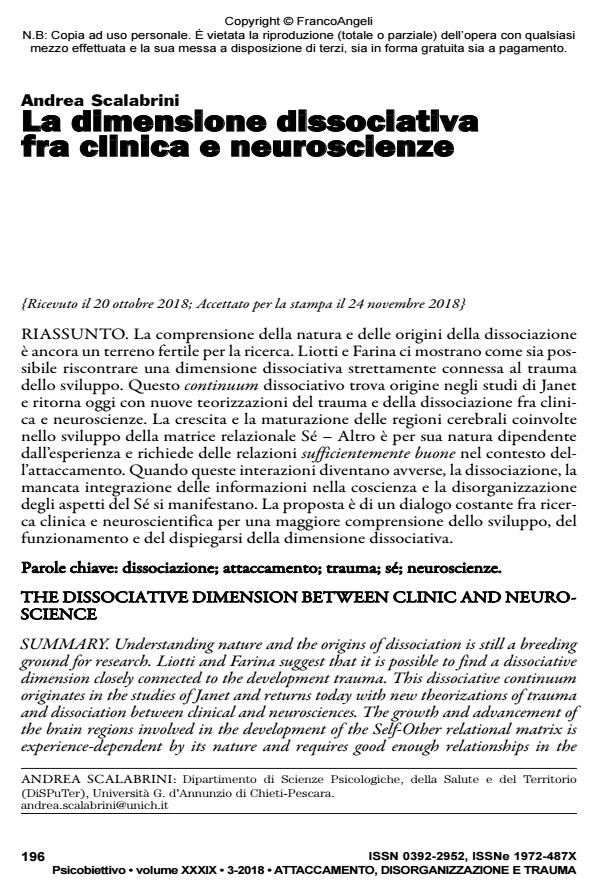The dissociative dimension between clinic and neuroscience
Journal title PSICOBIETTIVO
Author/s Andrea Scalabrini
Publishing Year 2018 Issue 2018/3 Language Italian
Pages 6 P. 196-201 File size 116 KB
DOI 10.3280/PSOB2018-003019
DOI is like a bar code for intellectual property: to have more infomation
click here
Below, you can see the article first page
If you want to buy this article in PDF format, you can do it, following the instructions to buy download credits

FrancoAngeli is member of Publishers International Linking Association, Inc (PILA), a not-for-profit association which run the CrossRef service enabling links to and from online scholarly content.
Understanding nature and the origins of dissociation is still a breeding ground for research. Liotti and Farina suggest that it is possible to find a dissociative dimension closely connected to the development trauma. This dissociative continuum originates in the studies of Janet and returns today with new theorizations of trauma and dissociation between clinical and neurosciences. The growth and advancement of the brain regions involved in the development of the Self-Other relational matrix is experience-dependent by its nature and requires good enough relationships in the attachment context. When these interactions become adverse, dissociation, lack of integration of the information within consciousness and the disorganization of the aspects of the Self are manifested. The proposal is to have a constant dialogue between clinical and neuroscientific research to gain a greater understanding of the development, functioning and unfolding of the dissociative dimension.
Keywords: Dissociation; Attachment; Trauma; Self; Neuroscience.
- American Psychiatric Association (2013) Diagnostic and statistical manual of mental disorders DSM-5®), American Psychiatric Pub
- Bromberg P.M. (1996) “Standing in the spaces: The multiplicity of self and the psychoanalytic relationship”, Contemporary Psychoanalysis, 32(4): 509-535 (trad. it.: Raffaello Cortina, Milano, 2006)
- Craig A.D. (2002) “How do you feel? Interoception: the sense of the physiological condition of the body”, Nature Reviews Neuroscience, 3(8): 655.
- Craig A.D. (2009) “How do you feel – now? The anterior insula and human awareness”, Nat. Rev. Neurosci., Jan;10(1): 59-70.
- Duncan N.W., Hayes D.J., Wiebking C., Tiret B., Pietruska K., Chen D.Q., Hodaie M. (2015) “Negative childhood experiences alter a prefrontal?insular?motor cortical network in healthy adults: A preliminary multimodal rsfMRI-fMRI-MRS-dMRI study”, Human Brain Mapping, 36(11): 4622-4637.
- Farina B., Speranza A.M., Dittoni S., Gnoni V., Trentini C., Vergano C.M., Della Marca G. (2014) “Memories of attachment hamper EEG cortical connectivity in dissociative patients”, European Archives of Psychiatry and Clinical Neuroscience, 264(5): 449-458.
- Fonagy P., Gergely G., Jurist E.J., Target M. (2002) Regolazione affettiva, mentalizzazione e sviluppo del Sé (trad. it.: Raffaello Cortina, Milano, 2005)
- Frewen P.A., Lanius R.A. (2006) “Toward a psychobiology of posttraumatic self-dysregulation: Reexperiencing, hyperarousal, dissociation, and emotional numbing”, Annals of the New York Academy of Sciences, 1071(1): 110-124.
- Janet P. (1989) L’automatisme Psychologique: Essai de Psychologie Expérimentale sur les Formes Inférieures de L’activité Humaine, Félix Alcan, Paris, 1889; Société Pierre Janet/Payot, Paris, 1973 (trad. it.: Raffaello Cortina, Milano, 2013)
- Lanius R.A., Vermetten E., Loewenstein R.J., Brand B., Schmahl C., Bremner J.D., Spiegel D. (2010) “Emotion modulation in PTSD: Clinical and neurobiological evidence for a dissociative subtype”, American Journal of Psychiatry, 167(6): 640-647.
- Lingiardi V., Mucci C. (2014) “Da Janet a Bromberg, passando per Ferenczi”, Psichiatria e Psicoterapia, 33(1)
- Liotti G. (2004) “Trauma, dissociation, and disorganized attachment: Three strands of a single braid”, Psychotherapy: Theory, Research, Practice, Training, 41(4): 472. DOI: 10.1037/0033-3204.41.4.47
- Liotti G., Farina B. (2011) Sviluppi Traumatici: eziopatogenesi, clinica e terapia della dimensone dissociativa, Raffaello Cortina, Milano
- Lyssenko L., Schmahl C., Bockhacker L., Vonderlin R., Bohus M., Kleindienst N. (2017) “Dissociation in psychiatric disorders: a meta-analysis of studies using the dissociative experiences scale”, American Journal of Psychiatry, 175(1): 37-46.
- Mucci C. (2008) Il dolore estremo: il trauma da Freud alla Shoah, Borla, Roma
- Vermetten E., Spiegel D. (2014) “Trauma and dissociation: implications for borderline personality disorder”, Current Psychiatry Reports, 16(2): 434.
- Van der Hart O., Nijenhuis E.R., Steele K. (2006) The haunted self: Structural dissociation and the treatment of chronic traumatization, WW Norton & Company, New York
- Schore A.N. (2000) “Attachment and the regulation of the right brain”, Attachment & Human Development, 2(1): 23-47. DOI: 10.1080/14616730036130
- Schimmenti A., Caretti V. (2016) “Linking the overwhelming with the unbearable: Developmental trauma, dissociation, and the disconnected self”, Psychoanalytic Psychology, 33(1): 106.
- Scalabrini A., Mucci C., Northoff G. (2018) “Is our self related to personality? A neuropsychodynamic model”, Frontiers in Human Neuroscience, 12: 346.
- Scalabrini A., Huang Z., Mucci C., Perrucci M.G., Ferretti A., Fossati A., Ebisch S.J. (2017) “How spontaneous brain activity and narcissistic features shape social interaction”, Scientific Reports, 7(1): 9986.
- Scalabrini A., Cavicchioli M., Fossati A., Maffei C. (2017) “The extent of dissociation in borderline personality disorder: a meta-analytic review”, Journal of Trauma & Dissociation, 18(4): 522-543.
- Sar V., Ross C. (2006) “Dissociative disorders as a confounding factor in psychiatric research”, Psychiatric Clinics, 29(1): 129-144
- Qin P., Northoff G. (2011) “How is our self related to midline regions and the default-mode network?”, Neuroimage, 57(3): 1221-1233.
- Putnam F.W. (1997) Dissociation in children and adolescents: A developmental perspective, Guilford Press, New York
- Pfeifer J.H., Peake S.J. (2012) “Self-development: integrating cognitive, socioemotional, and neuroimaging perspectives”, Developmental Cognitive Neuroscience, 2(1): 55-69.
- Mucci C. (in press) “A right brain dissociative model for right-brain disorders: Dissociation vs repression in borderline and other severe psychopathologies of early traumatic origin”, in Tweedy R. (ed.), The divided therapist: Hemispheric difference and contemporary psychotherapy, Routledge, London
- Mucci C. (2018b) Borderline Bodies. Affect Regulation Therapy For Personality Disorders. WW Norton & Company, New York
- Mucci C. (2018a) “Implicit memory, unrepressed unconscious, and trauma theory: The turn of the screw between contemporary psychoanalysis and neuroscience”, in Unrepressed unconscious, implicit memory, and clinical work, Routledge, Abingdon-on-Thames, UK, pp. 99-129
- Mucci C. (2014) Trauma e perdono. Una prospettiva psicoanalitica intergenerazionale, Raffaello Cortina, Milano
Andrea Scalabrini, La dimensione dissociativa fra clinica e neuroscienze in "PSICOBIETTIVO" 3/2018, pp 196-201, DOI: 10.3280/PSOB2018-003019